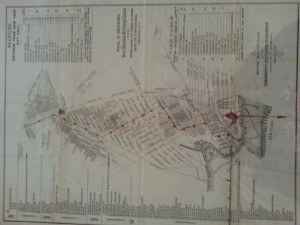There are many people who claim to know New York very well, yet most of the times when they say “New York” they are only referring to one borough in specific which most of the times ends up being Manhattan but, New York is not only about Manhattan, there are other boroughs too. One of those other boroughs is Brooklyn. One day while in Brooklyn I decided to take my time and explore around the surrounding area of the New York City College Of Technology, while on that trip I came upon a certain street by the name of Livingston St, that certain street had something that captivated my view and that was the Museum Of Transit. To get to the Museum Of Transit you must first head south on Jay St towards Johnson St, turn right in Willoughby St, turn left onto Pearl St, turn right on Red Hook Lin, turn left on Boeron and finally turn onto Livingston St.
While walking towards The New York City Museum Of Transit I noticed a lot of things, for example I saw that a lot of people walked in extreme urgency, also when I reached the museum I noticed that the museum itself could be seen from a distance thanks to those hanging posters from the sides. When looking at the Museum Of Transit I began to notice that the museum itself was a Juxtaposition, the reason for this claim is because the museum itself is a modern piece of work (meaning a building) but the items that the museum displays are historical artifacts or old artifacts.The display of the artifacts is also surrounded by modernism and technology making the museum a Juxtaposition.
The buildings around the museum are very similar to each other making the museum blend in with the modern structures, The Museum Of Transit would be very difficult to locate if it wasn’t for the directions provided by the MTA on their website and also because of the big posters hanging outside of the museum.
The reason I chose this location is because I ride the subway everyday of the week and often times when I see the trains I start to wonder who came with the idea of such a method of transportation. I have also been curious about the history of the subway and the history of the MTA in general for example: Why pick letters and numbers for the trains? or why chose the stations that we have and not other stations?.
When I entered the museum it was sort of like entering the train because the museum is located underground, the museum itself is pretty huge and exhibits models of old trains, stations and even buses. My favorite part of the museum is the store, the store offers merchandise that are faithful to the MTA. Personally my favorite item of the museum has to be the centennial chick poster because I remember that piece of art being in the train the first time I rode the subway.




